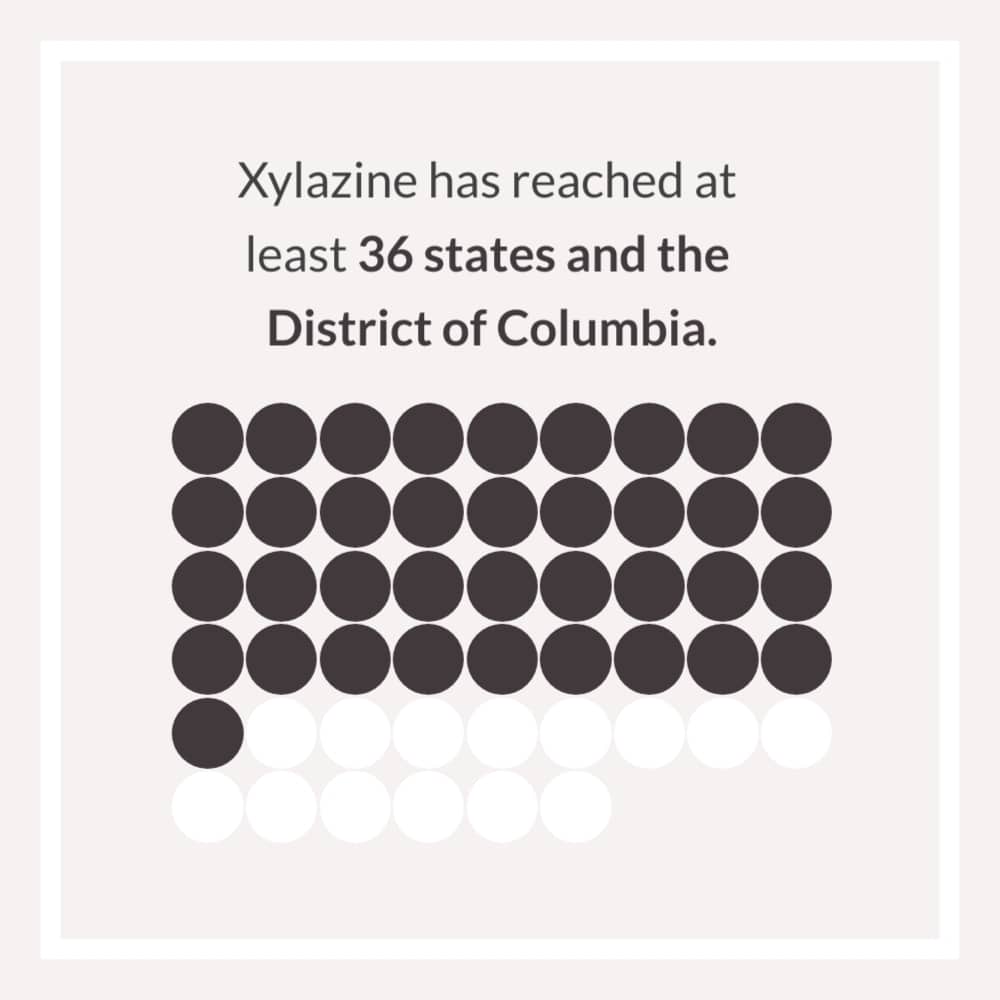
Xylazine (aka Tranq Dope): What You Need to Know
What is xylazine? It’s a new drug being mixed with fentanyl that has very dangerous side effects. It’s often called “tranq dope” or “zombie drug” because it’s a non-opioid sedative. Because it’s not a narcotic, its effects can’t be reversed with a dose of naloxone (Narcan), meaning that overdoses can easily end up being fatal. Beyond that, it causes the death of soft tissue, leading to gruesome, blackened wounds that can warrant amputation.
Because it’s not a narcotic, its effects can’t be reversed with a dose of naloxone (Narcan), meaning that overdoses can easily end up being fatal.
What Is Xylazine (Tranq Dope)?
What is tranq dope? According to the Drug Enforcement Administration (DEA), xylazine has never been approved for use in humans. It was first developed in 1962 by Bayer, but human clinical trials were shut down because of xylazine’s effect on blood pressure and the nervous system. It’s been used as a veterinary drug to sedate animals, from rats to elk, to facilitate handling or for surgical procedures.
Xylazine is a depressant, lowering heart rate and blood pressure, decreasing respiration, and suppressing the central nervous system. Combined with fentanyl, a synthetic opioid that is also a depressant, fatal overdoses become more likely. Fentanyl overdoses may be reversed with naloxone, which blocks the effects of opioids; but because xylazine is not an opioid, it does not respond to naloxone. Also, it doesn’t show up on routine drug tests or tox screens at this time, making it harder to identify and treat its influence.
Fentanyl is up to 50 times more potent than heroin, and its presence in the drug supply has sparked a rise in overdose deaths. According to the Centers for Disease Control and Prevention (CDC), over 71,000 overdose deaths in 2021 could be attributed to synthetic opioids like fentanyl.
The combination of xylazine and fentanyl has driven an increase in casualties and grisly side effects, such as skin ulcers, abscesses, and festering wounds that can require amputation. A 2022 Cureus study suggests that xylazine causes tissue death because it suppresses blood flow; without access to blood, skin and muscle tissue become damaged and can’t heal, which causes them to blacken and begin to die.
The Spread of Xylazine
In January 2023, The New York Times analyzed the rising prevalence of xylazine in the US drug supply. They reported several alarming facts about its spread in major cities:

- More than 90% of Philadelphia’s lab-tested samples of dope have tested positive for xylazine.
- Xylazine has reached at least 36 states and the District of Columbia.
- Of drug samples in New York City, 25% have tested positive for xylazine.
- Health officials say the spread of xylazine is underestimated, especially since hospitals don’t yet test for it.
According to the National Institute on Drug Abuse (NIDA), drug overdose deaths involving xylazine increased by 24% in Pennsylvania between 2015 and 2020. In 2020, xylazine was a factor in 10% of drug overdose deaths in Connecticut; in 2021, it was a contributor to 19% of all drug overdose deaths in Maryland.
Xylazine has reached at least 36 states and the District of Columbia.
The onset of the pandemic is largely seen as the inflection point for xylazine’s usage rates. Its accessibility as a veterinary drug, especially online, made it a target for drug users. Additionally, it became half as expensive to acquire as heroin.
Tranq Dope Effects: What to Watch For
Tranq dope effects can be similar to opioid effects, with some critical differences. According to Drugs.com, side effects of xylazine may include:
- Slow heart rate
- Respiratory depression
- Low blood pressure
- Blurred vision
- Staggering
- Drowsiness, disorientation
- Coma
Those who have used tranq dope may have wounds that are slow to heal, including skin ulcers, abscesses, or lacerations that may turn black. In an overdose situation, naloxone may help reverse the effects of fentanyl, but there’s currently no treatment for a xylazine overdose. The medicines used to counteract xylazine’s effects in animals are not approved for human use.
It’s important to remember that someone who is sleeping after drug use and snoring is not necessarily safe; snoring can be a sign of hampered breathing. Keeping the airway clear is vital; at the hospital, fluids and electrolytes will often be administered.
Tranq dope can cause severe withdrawal symptoms, including the following:
- Migraines
- Double vision
- Nausea
- Numbness in fingers and toes
- Sweats
- Anxiety
There is currently no treatment for xylazine withdrawal symptoms, though anti-anxiety medications have been used to help alleviate them.
If you suspect that someone has overdosed from tranq dope, call 911, and be sure to notify them that tranq dope may be involved. It may inform the way they treat the affected person.
You Can Heal from Drug Addiction
If you or someone you love is struggling with drug addiction, it’s easy to feel hopeless and helpless. But you can heal from the devastation of drug addiction, even an addiction to tranq dope. Get the support and treatment you need from our team at The Meadows Outpatient Center. We will help you rediscover your true self and get back on your feet again. Contact us today to learn more.

Reach Out Today
Convenient, comprehensive care is available. Your next chapter can start right now.